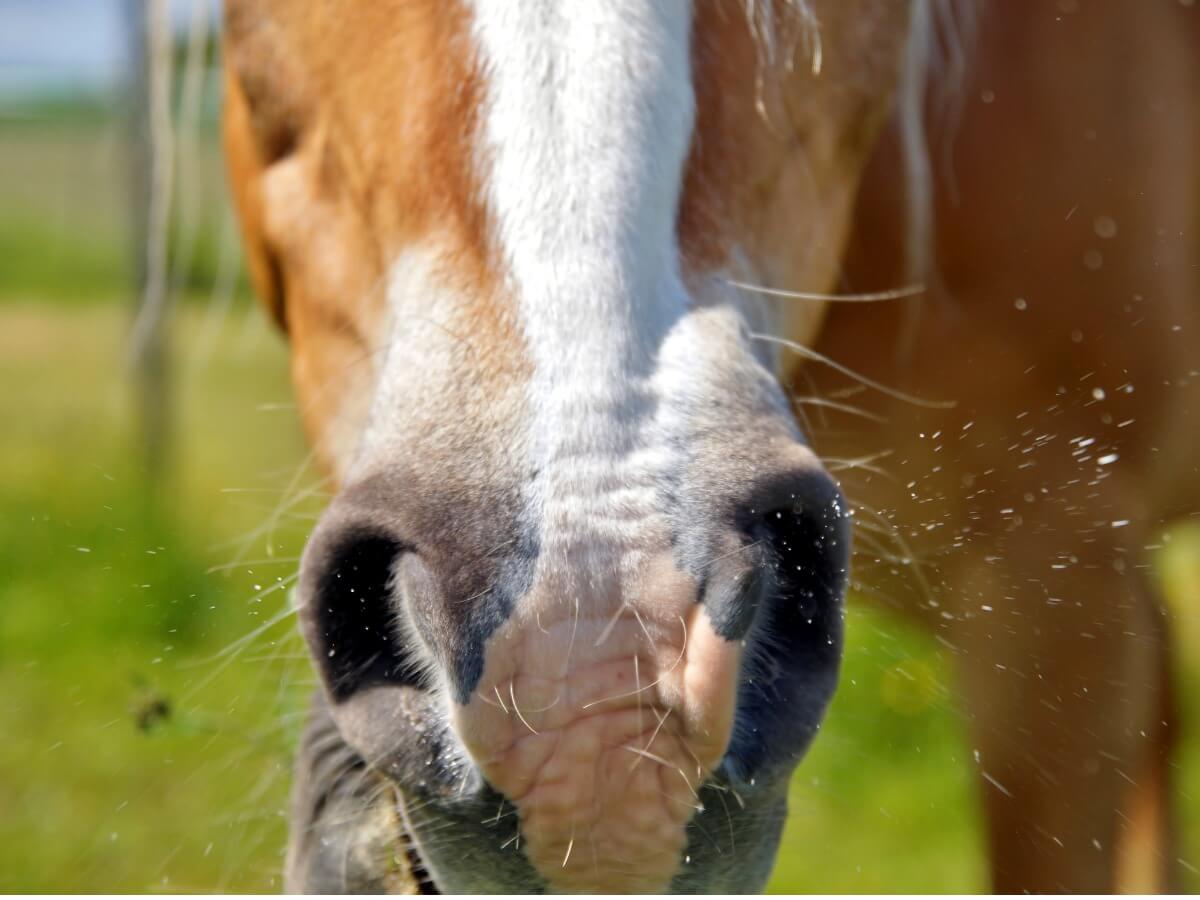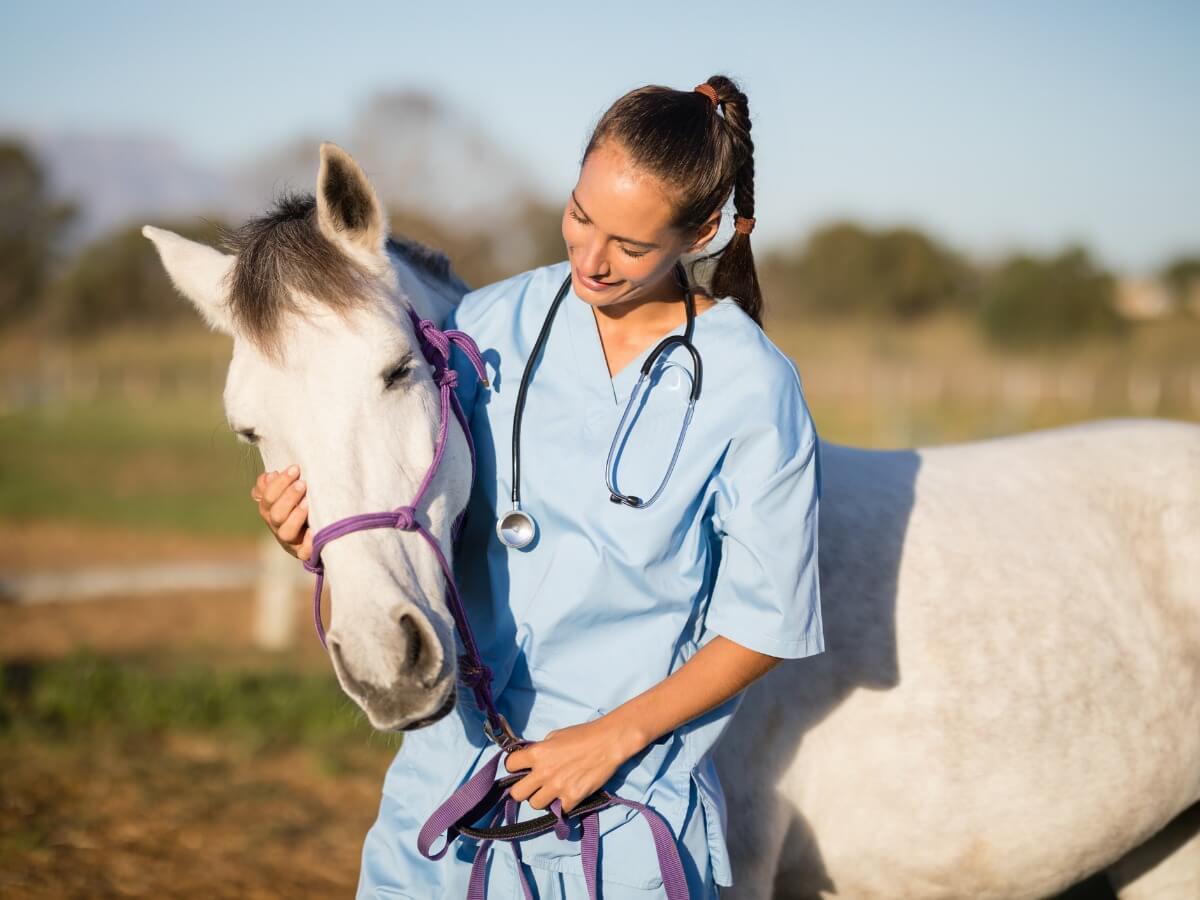What Is Equine Rhinopneumonitis?


Written and verified by the vet Daniel Aguilar
Although all the diseases animals are exposed to must be taken seriously by their owners, there are some that, due to their characteristics, tend to be more aggressive than others. Equine rhinopneumonitis is one of the most serious conditions in the world of equines.
Horses can become very susceptible to acute illnesses, which in turn lead to secondary complications and can be life-threatening. It’s very important to know how to act at the right time to avoid infections and casualties. We invite you to continue reading and discover more about this disease.
Is equine rhinopneumonitis a virus?
Equine rhinopneumonitis is a disease of viral origin. It’s characterized by its high rate of infection mainly in horses, although it can also affect donkeys and mules.
The causative agent of equine rhinopneumonitis is an equine herpesvirus of the Herpesviridae family and of the Varicelovirus genus. Its incubation period is very short and the animal has a fever within the first 24-48 hours after infection. Over the next 5 to 7 days, the other clinical signs begin to appear.
It’s a very resistant virus, capable of surviving up to a month in the environment – under ideal conditions. The importance of good management of animals and facilities in the presence of this herpes virus is key to reducing the high economic losses that characterize the disease.

Differences between EVH-1 and EVH-4
There are 2 subtypes of equine herpesvirus, both causing equine rhinopneumonitis. Each of them triggers a series of reactions and signs that distinguish them from each other. We explore them briefly below.
HVE-1
It causes a serious respiratory disease that affects mostly young horses. It also causes miscarriages from the seventh month of gestation and high neonatal mortality. Diseases such as myeloencephalopathy, accompanied by nervous signs in response to damage to the central or peripheral nervous system, are common in these conditions.
Weakness, atony of the urinary bladder, ataxia, and abnormal movements are some of the symptoms that you can see manifesting in horses infected by this type of herpes virus. If there are any symptoms, separate the animal from the rest until it can be verified, thus avoiding contagion.
HVE-4
It’s considered a slightly less aggressive viral variant than HVE-1. The type of equine rhinopneumonitis that it causes is associated with a mild respiratory disease and, in some cases, the presence of miscarriages. This type of virus gains access to the body through the respiratory tract, replicating in the nasal cavity, pharynx, trachea, mucosa, and local lymphoid tissue.
Symptoms of equine rhinopneumonitis
As we mentioned previously, equine rhinopneumonitis doesn’t have an exclusive symptomology, which is why it can be difficult to diagnose. However, the clinical picture that has been seen in most patients affected by this pathology is as follows:
- Cough
- Lethargy
- Mucous congestion
- Fever
- Inflammation of the lymph nodes, trachea, and bronchi
- Watery nasal discharge
- Anorexia
Foals with pneumonia
In adults, apart from a discharge of serous mucus, there are usually no other complications. However, foals are the ones most affected by equine rhinopneumonitis.
Its acute symptoms begin with fever, abundant discharge from the nostrils —first serous and later mucopurulent—, conjunctivitis, and lacrimation. Swollen lymph nodes and excessive coughing are also common clinical signs.
In addition, the capillaries of the respiratory tract are often affected by viral infection. Sometimes injuries to the respiratory system are so severe that they can lead to severe respiratory failure. In these cases, the outcome is usually fatal.
On the other hand, the animals that are born —even when the mother has equine rhinopneumonitis during pregnancy— tend to be weak, sick, unable to suckle, and with marked respiratory distress. Mortality reaches 100% in these cases, so the viability of these foals is almost nil.
A favorable prognosis is determined when there has been no secondary bacterial infection. If so, the foal will recover in 2 to 3 weeks.
Term abortions
The virus is capable of invading blood cells at the respiratory level. It travels through the circulation until it colonizes the maternal uterus, where it produces numerous thrombi. In the same way, the fetus of an infected pregnant mother will also be affected, since necrotic areas will be generated in it.
The higher the number of thrombi that occur, the greater the probability that proper blood circulation cannot be maintained and that the placenta will detach, triggering miscarriages. Mares that are between the seventh and eleventh months of gestation are more likely to lose their offspring.
Neurological symptoms
In equine rhinopneumonitis, the virus can travel to different parts of the body and sometimes reach the nervous system. As a consequence, various neurological signs can occur in horses, such as urinary incontinence, incoordination of movements, inability to stand, paralyzed tongue, and fecal retention.
How is the disease diagnosed?
As it’s a disease whose signs can be very similar to other pathologies, the vet will use several tools to establish a definitive diagnosis. They’ll need to identify the DNA or antigen of the virus. Samples such as nasopharyngeal swabs, tracheobronchial washes, and aborted equine products will be recommended.
The most useful test for the detection of the different types of herpes viruses that cause equine rhinopneumonitis is the polymerase chain reaction (PCR). Viral isolation by the culture of infected animal tissue, together with the ELISA technique for the detection of antibodies, are also widely used by veterinarians.
In PCR, the genetic information of the virus present in the sample of the diseased equid is amplified.
Equine rhinopneumonitis in Europe
Competition horses have recently been involved in a major outbreak of equine rhinopneumonitis, which originated in an equestrian center in Valencia (Spain) at the end of February 2021. For this reason, the Royal Spanish Equestrian Federation decided to suspend all activities and requested veterinarians to carry out an epidemiological investigation of the outbreak.
Due to the deaths that this outbreak has brought, the International Equestrian Federation has considered this outbreak of equine rhinopneumonia as the most serious one that has occurred in Europe in decades.

Isolation of infected animals, reduction of stress levels, and preventive vaccination are the best measures to prevent and control the presentation and spread of the virus. Remember, equine rhinopneumonitisis is highly contagious, so it’s in your hands to avoid this condition in your animals. Act responsibly and notify the authorities.
Although all the diseases animals are exposed to must be taken seriously by their owners, there are some that, due to their characteristics, tend to be more aggressive than others. Equine rhinopneumonitis is one of the most serious conditions in the world of equines.
Horses can become very susceptible to acute illnesses, which in turn lead to secondary complications and can be life-threatening. It’s very important to know how to act at the right time to avoid infections and casualties. We invite you to continue reading and discover more about this disease.
Is equine rhinopneumonitis a virus?
Equine rhinopneumonitis is a disease of viral origin. It’s characterized by its high rate of infection mainly in horses, although it can also affect donkeys and mules.
The causative agent of equine rhinopneumonitis is an equine herpesvirus of the Herpesviridae family and of the Varicelovirus genus. Its incubation period is very short and the animal has a fever within the first 24-48 hours after infection. Over the next 5 to 7 days, the other clinical signs begin to appear.
It’s a very resistant virus, capable of surviving up to a month in the environment – under ideal conditions. The importance of good management of animals and facilities in the presence of this herpes virus is key to reducing the high economic losses that characterize the disease.

Differences between EVH-1 and EVH-4
There are 2 subtypes of equine herpesvirus, both causing equine rhinopneumonitis. Each of them triggers a series of reactions and signs that distinguish them from each other. We explore them briefly below.
HVE-1
It causes a serious respiratory disease that affects mostly young horses. It also causes miscarriages from the seventh month of gestation and high neonatal mortality. Diseases such as myeloencephalopathy, accompanied by nervous signs in response to damage to the central or peripheral nervous system, are common in these conditions.
Weakness, atony of the urinary bladder, ataxia, and abnormal movements are some of the symptoms that you can see manifesting in horses infected by this type of herpes virus. If there are any symptoms, separate the animal from the rest until it can be verified, thus avoiding contagion.
HVE-4
It’s considered a slightly less aggressive viral variant than HVE-1. The type of equine rhinopneumonitis that it causes is associated with a mild respiratory disease and, in some cases, the presence of miscarriages. This type of virus gains access to the body through the respiratory tract, replicating in the nasal cavity, pharynx, trachea, mucosa, and local lymphoid tissue.
Symptoms of equine rhinopneumonitis
As we mentioned previously, equine rhinopneumonitis doesn’t have an exclusive symptomology, which is why it can be difficult to diagnose. However, the clinical picture that has been seen in most patients affected by this pathology is as follows:
- Cough
- Lethargy
- Mucous congestion
- Fever
- Inflammation of the lymph nodes, trachea, and bronchi
- Watery nasal discharge
- Anorexia
Foals with pneumonia
In adults, apart from a discharge of serous mucus, there are usually no other complications. However, foals are the ones most affected by equine rhinopneumonitis.
Its acute symptoms begin with fever, abundant discharge from the nostrils —first serous and later mucopurulent—, conjunctivitis, and lacrimation. Swollen lymph nodes and excessive coughing are also common clinical signs.
In addition, the capillaries of the respiratory tract are often affected by viral infection. Sometimes injuries to the respiratory system are so severe that they can lead to severe respiratory failure. In these cases, the outcome is usually fatal.
On the other hand, the animals that are born —even when the mother has equine rhinopneumonitis during pregnancy— tend to be weak, sick, unable to suckle, and with marked respiratory distress. Mortality reaches 100% in these cases, so the viability of these foals is almost nil.
A favorable prognosis is determined when there has been no secondary bacterial infection. If so, the foal will recover in 2 to 3 weeks.
Term abortions
The virus is capable of invading blood cells at the respiratory level. It travels through the circulation until it colonizes the maternal uterus, where it produces numerous thrombi. In the same way, the fetus of an infected pregnant mother will also be affected, since necrotic areas will be generated in it.
The higher the number of thrombi that occur, the greater the probability that proper blood circulation cannot be maintained and that the placenta will detach, triggering miscarriages. Mares that are between the seventh and eleventh months of gestation are more likely to lose their offspring.
Neurological symptoms
In equine rhinopneumonitis, the virus can travel to different parts of the body and sometimes reach the nervous system. As a consequence, various neurological signs can occur in horses, such as urinary incontinence, incoordination of movements, inability to stand, paralyzed tongue, and fecal retention.
How is the disease diagnosed?
As it’s a disease whose signs can be very similar to other pathologies, the vet will use several tools to establish a definitive diagnosis. They’ll need to identify the DNA or antigen of the virus. Samples such as nasopharyngeal swabs, tracheobronchial washes, and aborted equine products will be recommended.
The most useful test for the detection of the different types of herpes viruses that cause equine rhinopneumonitis is the polymerase chain reaction (PCR). Viral isolation by the culture of infected animal tissue, together with the ELISA technique for the detection of antibodies, are also widely used by veterinarians.
In PCR, the genetic information of the virus present in the sample of the diseased equid is amplified.
Equine rhinopneumonitis in Europe
Competition horses have recently been involved in a major outbreak of equine rhinopneumonitis, which originated in an equestrian center in Valencia (Spain) at the end of February 2021. For this reason, the Royal Spanish Equestrian Federation decided to suspend all activities and requested veterinarians to carry out an epidemiological investigation of the outbreak.
Due to the deaths that this outbreak has brought, the International Equestrian Federation has considered this outbreak of equine rhinopneumonia as the most serious one that has occurred in Europe in decades.

Isolation of infected animals, reduction of stress levels, and preventive vaccination are the best measures to prevent and control the presentation and spread of the virus. Remember, equine rhinopneumonitisis is highly contagious, so it’s in your hands to avoid this condition in your animals. Act responsibly and notify the authorities.
All cited sources were thoroughly reviewed by our team to ensure their quality, reliability, currency, and validity. The bibliography of this article was considered reliable and of academic or scientific accuracy.
Europa se enfrenta al mayor brote de rinoneumonía equina en décadas. Madrid, España. 2 de marzo de 2021. Consultado el 25 de junio de 2021. Disponible en: https://www.animalshealth.es/equino/europa-enfrenta-mayor-brote-rinoneumonia-equina-decadas
Villalva M. Rinoneumonitis equina. Madrid, España. Consultado el 25 de junio de 2021. Disponible en: https://www.equisan.com/index.php/33-aula-magna/medicina-interna/aparato-respiratorio/250-rinoneumonitis-equina
Ministerio de Agricultura, Pesca y Alimentación. Rinoneumonía equina. España. Consultado el 25 de junio de 2021. Disponible en: https://www.mapa.gob.es/es/ganaderia/temas/sanidad-animal-higiene-ganadera/sanidad-animal/enfermedades/Rinoneumonia_Equina.aspx
Ministerio de Agricultura Pesca y Alimentación. Rinoneumonía equina. Protocolo de actuación ante la sospecha y confirmación de un foco. España. Consultado el 25 de junio de 2021. Disponible en: https://www.mapa.gob.es/es/ganaderia/temas/sanidad-animal-higiene-ganadera/protocolorinoneumoniaequinajunio2020_tcm30-535814.pdf
Rinoneumonitis equina: la enfermedad que juega al despiste. España. 4 de febrero de 2020. Consultado el 25 de junio de 2021. Disponible en: https://www.pavo-horsefood.es/blog/rinoneumonitis-equina/107#:~:text=La%20rinoneumonitis%20equina%20es%20producida,neumon%C3%ADa%20al%20poco%20de%20nacer.
El mundo del caballo vuelve a la normalidad tras la rinoneumonía equina. Madrid, España. 14 de abril de 2021. Consultado el 25 de junio de 2021. Disponible en: https://www.animalshealth.es/equino/mundo-caballo-vuelve-normalidad-tras-rinoneumonia-equina
García L. Rinoneumonitis equina – Síntomas y tratamiento. España. 24 de noviembre de 2021. Consultado el 25 de junio de 2021. Disponible en: https://www.expertoanimal.com/rinoneumonitis-equina-sintomas-y-tratamiento-25228.html#anchor_2
This text is provided for informational purposes only and does not replace consultation with a professional. If in doubt, consult your specialist.








